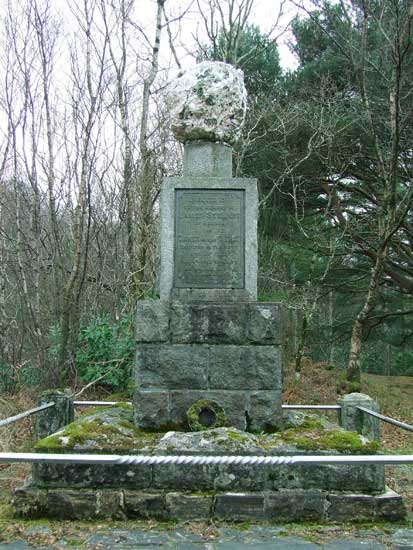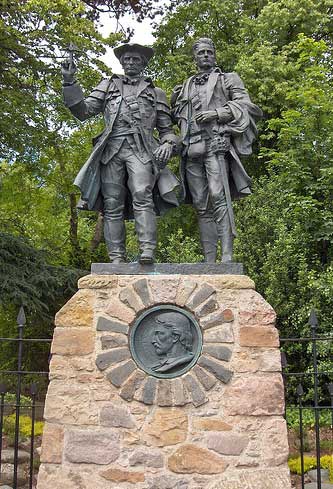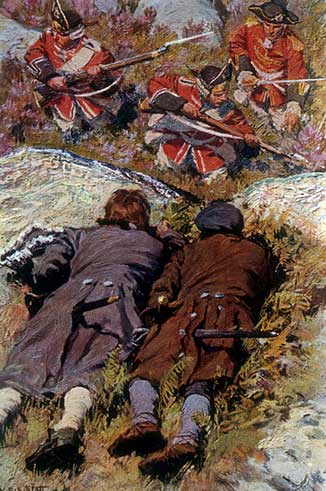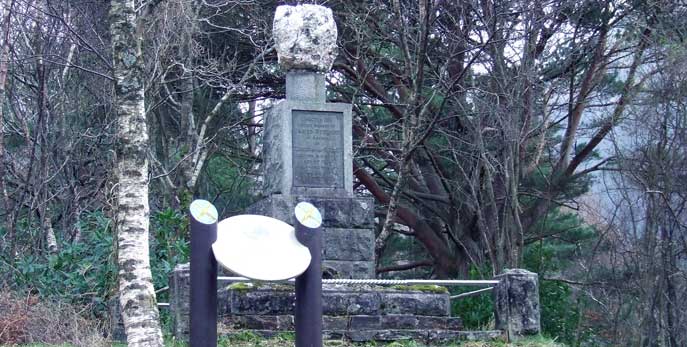THE APPIN MURDER 1752 |
 |
For eighteen months the body of James Stewart - James of the Glen - was left to hang on the gibbet at an elevated and highly visible spot on the south end of the Ballachulish Ferry. Battered by the winds and rain of the west Highlands, Stewarts' body rapidly disintegrated. It was a sinister aftermath to one of the most shameful episodes in Scottish history - the Appin Murder. It claimed the lives of two men - one killed by sniper fire, the second "judicially" murdered after a rigged trial which paid no heed to justice, only the needs of vengeance and political expediency. Stewart unquestionably went to the gallows an innocent man. His own clan family knew that from the beginning but refused to turn in the guilty man. Instead, in one of the best kept secrets in history, the identity of the killer was passed down to selected Stewarts through generations before being revealed - apparently - only four years ago. The Appin Murder happened in May 1752, six years after the Battle of Culloden. |
The dead man was Colin Campbell of Glenure, Argyllshire. Known as "The Red Fox", he was the factor of several estateswhich had been forfeited from pro-Jacobite clans and his challenging task was to collect taxes from clan leaders. It has been claimed that on the day he was shot Campbell was about to indulge in a spot of "ethnic cleansing" by evicting Stewart families from their houses on the Ardsheal estate and replacing them with Campbells. That claim has never been proved but post-Culloden, anti-Campbell sentiment was rife in the west Highlands. The Campbells, living in the heart of clan country, were however loyal to the Hanoverian monarchy and deeply unpopular among those who had fought with Charles Edward Stewart, the Bonnie Prince himself. They had also been seen to "do the bidding of their English masters" at the Massacre of Glencoe 60 years earlier. Colin Roy Campbell was 44 and ambitious. His work was distasteful but the more fair-minded regarded him as a decent man who made the best of a difficult job. At Ardsheal, James of the Glen helped him collect Stewart rents and the two men often consulted. On 14 May, Campbell and four others had just crossed Loch Leven on the ferry and were passing the road at Lettermore Wood when a musket shot rang out. Campbell lay dead and the killer disappeared into the rugged countryside. |
Within two days James of the Glen had been arrested and taken for trial to the Campbell stronghold of Inveraray Castle. The trial was a travesty. Eleven of the 15 jurors were Campbells and the presiding judge was the Duke of Argyll, the clan chief. Not surprisingly Stewart was sentenced to die. It is said that on the day of the hanging, the real man who fired the shot had to be held down at a house in Ballachulish to prevent him giving himself up. One of those who fell under suspicion was Stewart's half-brother, Alan Breck Stewart, described as a vengeful young hothead who had stirred up anti-Campbell hatred among his clansmen. Robert Louis Stevenson became so fascinated with the story that he based the novels Kidnapped and Catriona on the episode - with Alan Breck as one of the leading characters. In 2001, nearly 250 years after the incident, an 89-year-old descendant of the Stewarts of Appin, Anda Penman, claimed it was time to break the family silence. She said the murder was planned by four young Stewart lairds and that the gun was fired by the best shot among the four, Donald Stewart of Ballachulish, who had been elected assassin. Penman died soon afterwards and no member of the Stewart family has substantiated her incredible story. Back in 1754 the sight of the remains of James Stewart was too much for a local half-wit known as "Daft Macphee". It is said he uprooted the gallows and threw it into Loch Linnhe and that it then floated into Loch Etive before coming to rest further south near Bonawe. The wooden gibbet was used as a bridge across stream and the bones of James of the Glen were carefully gathered and buried - by none other than young Donald Stewart of Ballachulish. |
 |
Kidnapped Murder Solved After 250 Years? |
Camillo Fracassini |
 |
It is not simply Scotland’s most famous unsolved murder — it is also a painful symbol of Scottish repression and injustice set against the lost Jacobite cause. Now it is claimed the 250- year-old mystery that inspired the opening to Kidnapped, Robert Louis Stevenson’s epic novel, was cracked by an academic just before her death. A posthumous book by Lee Holcombe, late professor of history at the University of South Carolina, says the wrong man was hanged for the 1752 murder and names the real culprit. It was six years after the battle of Culloden, which signalled the end of the Jacobite uprising against the English crown, when Colin Campbell of Glenure, a government appointed factor, was shot in the back in as he rode through Lettermore wood, south of Ballachulish, Argyll. He had been on his way to Appin to evict members of the Stewart clan, who had fought on the side of Bonnie Prince Charlie at Culloden. As punishment for siding with the Jacobites, much of the Stewart land was confiscated and handed over to the pro-Hanoverian Campbells. The killing of a government official caused outrage. Fearing another rebellion, the government launched a manhunt, offering a reward of £100 for the capture of the killer. Alan Breck Stewart, who was well known to the authorities as a Jacobite, was the main suspect. He had made threats against Campbell in the weeks before the murder and fled to France immediately afterwards. Stevenson’s novel begins with him fleeing the murder scene accompanied by the fictional David Balfour. |
In Alan Breck’s absence, the authorities focused their attention on James Stewart, who had organised resistance to the Appin evictions. He was tried by a 15-man jury — which included 11 Campbells — at the High Court of Justiciary in Inveraray and was found guilty of being an accessory to the murder and hanged. He died protesting his innocence and his body was left to rot on a gibbet on a prominent site above the ferry at Ballachulish as a warning to his fellow clansmen. However, following a 20- year investigation, Holcombe believed that James was innocent. She reveals that it was Donald Stewart, nephew of the laird of Ballachulish, who fired the fatal shot. In her book, Ancient Animosity: The Appin Murder and the End of Scottish Rebellion, due to be published posthumously next month, Holcombe draws on nearly 500 contemporary sources to prove that Donald Stewart was the murderer. According to her exhaustive investigation, a shooting competition was held before the killing to choose the assassin. The winner was Donald Stewart, who was found to be “the best hand at the gun” and was selected “to do the special hunting”. Holcombe also discovered that investigators did not ask Donald Stewart to explain his whereabouts at the time of the murder. He helped to recover Campbell’s body, setting off with a party from Ballachulish House, home of the laird of Ballachulish. It was assumed that he would not have had the time to carry out the killing in Lettermore wood, travel to Ballachulish House and then join the group that recovered Campbell’s body. However, Holcombe discovered that nearly two hours elapsed between the killing and the arrival of the group from Ballachulish — more than enough time for Stewart to carry out the killing, get rid of the murder weapon, change his clothes and return to the scene of the crime. The book also reveals that the killer was overcome with remorse when James Stewart was convicted: “Donald wanted to give himself up to the authorities and confess his guilt, but his friends urged him to keep the secret being ‘very much afraid . . . that information might be obtained of everyone who had joined in the plot for killing Colin of Glenure’.” According to local folklore, Stewart “went away to sea”, not returning to Scotland until he was an old man. Holcombe died in 2002 before her 1,200-page manuscript could be published. Her son, Tim Breen, took on the task of editing his mother’s work. “She devoted the last 20 years of her life to this investigation,” said Breen. “She would spend all her spare time researching the murder, ordering books from British libraries, and she travelled to Scotland in 1986.” |
 |
 |
© Paisley Tartan Army 2008-09
